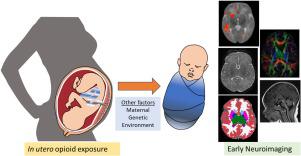Journal of Neuroradiology ( IF 3.0 ) Pub Date : 2020-10-13 , DOI: 10.1016/j.neurad.2020.09.009 Rupa Radhakrishnan 1 , Gregory Grecco 2 , Kellen Stolze 3 , Brady Atwood 4 , Samuel G Jennings 1 , Izlin Z Lien 5 , Andrew J Saykin 1 , Senthilkumar Sadhasivam 6

|
Prenatal opioid exposure (POE) has shown to be a risk factor for adverse long-term cognitive and behavioral outcomes in offspring. However, the neural mechanisms of these outcomes remain poorly understood. While preclinical and human studies suggest that these outcomes may be due to opioid-mediated changes in the fetal and early postnatal brain, other maternal, social, and environmental factors are also shown to play a role. Recent neuroimaging studies reveal brain alterations in children with POE. Early neuroimaging and novel methodology could provide an in vivo mechanistic understanding of opioid mediated alterations in developing brain. However, this is an area of ongoing research. In this review we explore recent imaging developments in POE, with emphasis on the neonatal and infant brain, and highlight some of the challenges of imaging the developing brain in this population. We also highlight evidence from animal models and imaging in older children and youth to understand areas where future research may be targeted in infants with POE.
中文翻译:

产前阿片类药物暴露婴儿的神经影像学:当前证据、最新进展和未来研究目标
产前阿片类药物暴露(POE)已被证明是导致后代长期不良认知和行为结果的危险因素。然而,这些结果的神经机制仍然知之甚少。虽然临床前和人类研究表明,这些结果可能是由于阿片类药物介导的胎儿和产后早期大脑变化所致,但其他母体、社会和环境因素也被证明发挥了作用。最近的神经影像学研究揭示了 POE 儿童的大脑变化。早期的神经影像学和新颖的方法可以提供对阿片类药物介导的大脑发育改变的体内机制的理解。然而,这是一个正在进行的研究领域。在这篇综述中,我们探讨了 POE 成像的最新进展,重点是新生儿和婴儿大脑,并强调了对该人群中发育中的大脑进行成像的一些挑战。我们还强调了来自年龄较大儿童和青少年的动物模型和影像学证据,以了解未来研究可能针对患有 POE 的婴儿的领域。









































 京公网安备 11010802027423号
京公网安备 11010802027423号